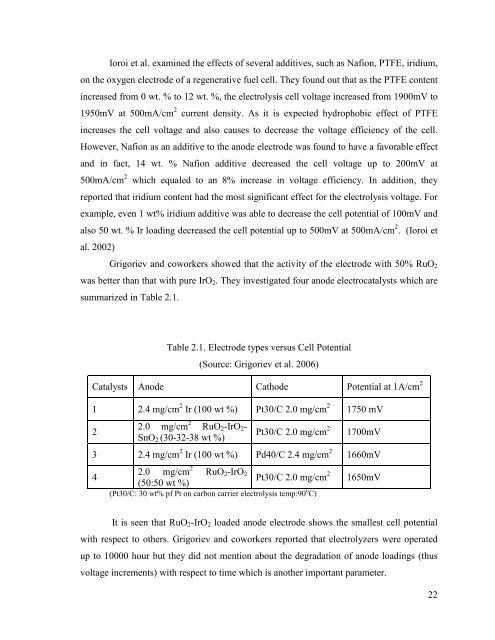hydrogen production from water using solar cells powered nafion ...
hydrogen production from water using solar cells powered nafion ...
hydrogen production from water using solar cells powered nafion ...
Create successful ePaper yourself
Turn your PDF publications into a flip-book with our unique Google optimized e-Paper software.
Ioroi et al. examined the effects of several additives, such as Nafion, PTFE, iridium,<br />
on the oxygen electrode of a regenerative fuel cell. They found out that as the PTFE content<br />
increased <strong>from</strong> 0 wt. % to 12 wt. %, the electrolysis cell voltage increased <strong>from</strong> 1900mV to<br />
1950mV at 500mA/cm 2 current density. As it is expected hydrophobic effect of PTFE<br />
increases the cell voltage and also causes to decrease the voltage efficiency of the cell.<br />
However, Nafion as an additive to the anode electrode was found to have a favorable effect<br />
and in fact, 14 wt. % Nafion additive decreased the cell voltage up to 200mV at<br />
500mA/cm 2 which equaled to an 8% increase in voltage efficiency. In addition, they<br />
reported that iridium content had the most significant effect for the electrolysis voltage. For<br />
example, even 1 wt% iridium additive was able to decrease the cell potential of 100mV and<br />
also 50 wt. % Ir loading decreased the cell potential up to 500mV at 500mA/cm 2 . (Ioroi et<br />
al. 2002)<br />
Grigoriev and coworkers showed that the activity of the electrode with 50% RuO2<br />
was better than that with pure IrO2. They investigated four anode electrocatalysts which are<br />
summarized in Table 2.1.<br />
Table 2.1. Electrode types versus Cell Potential<br />
(Source: Grigoriev et al. 2006)<br />
Catalysts Anode Cathode Potential at 1A/cm 2<br />
1 2.4 mg/cm 2 Ir (100 wt %) Pt30/C 2.0 mg/cm 2<br />
2<br />
2.0 mg/cm 2 RuO2-IrO2-<br />
SnO2 (30-32-38 wt %)<br />
Pt30/C 2.0 mg/cm 2<br />
3 2.4 mg/cm 2 Ir (100 wt %) Pd40/C 2.4 mg/cm 2<br />
4<br />
2.0 mg/cm 2 RuO2-IrO2<br />
(50:50 wt %)<br />
Pt30/C 2.0 mg/cm 2<br />
(Pt30/C: 30 wt% pf Pt on carbon carrier electrolysis temp:90 o C)<br />
1750 mV<br />
1700mV<br />
1660mV<br />
1650mV<br />
It is seen that RuO2-IrO2 loaded anode electrode shows the smallest cell potential<br />
with respect to others. Grigoriev and coworkers reported that electrolyzers were operated<br />
up to 10000 hour but they did not mention about the degradation of anode loadings (thus<br />
voltage increments) with respect to time which is another important parameter.<br />
22

















